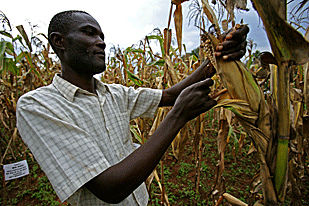Malawi’s dependence on maize has led to malnutrition, will encouraging permaculture help Malawians increase their intake of micronutrients?
As the third highest per capita consumers of maize in the world, Malawi’s dependence on a grain with high energy content but low protein, fat, and micronutrient quality has led to sustained issues of malnutrition. Despite recent praise of Malawi’s efforts to end hunger from the head of the Food and Agriculture Organisation (FAO) José Graziano da Silva, this southern African country still has high rates of stunting in children under five, and high rates of anaemia and vitamin A deficiency are putting the population at high risk for impaired cognitive development.
In an effort to address malnutrition, the government of Malawi created an Essential Nutrition Action Program that introduced the fortification of sugar with vitamin A. Unfortunately, in a country where 50.7% of the population live below the poverty line, vitamin A-enriched sugar is an unaffordable luxury to those who need it most.
With 85% of Malawians working as subsistence farmers, a food-based approach is a more viable adjunct to fortification. Permaculture is one such approach that’s being adopted by rural farmers in Malawi. It is a design method that mimics natural systems to decrease the need for outside inputs and increase biological diversity. This approach meets human needs for food, fuel, and fodder and, unlike fortified foods, it is accessible to households across the economic spectrum. By emphasising the use of existing resources, seeds are saved and shared at little to no cost.
The focus on diversity within permaculture has a number of practical impacts for subsistence farmers. In addition to increasing accessibility of nutritious foods, it also allows for year round, seasonal and perennial harvests, helping to turn the “hungry season” into a time of abundance. Additionally, crop diversity increases agricultural resilience in the face of climate change.
Preliminary results from a recent study, presented at the Conservation Agriculture symposium this year, showed that, on average, permaculture farmers planted nearly twice the number of vegetables and over twice the number of fruits and legumes than conventional farmers. The benefits of this diversity were demonstrated in food access and nutritional intake of the families. Permaculture households ranked higher in measures of food security and diet diversity, including consumption of micronutrient rich fruits and vegetables.
The Kusamala Institute of Agriculture and Ecology, a local non-profit that promotes permaculture in Malawi, has had similar success. In partnership with the Red Soil Project , Kusamala is training staff members in implementing household permaculture gardens.
While permaculture seems to be an obvious solution, its proponents have faced challenges in its implementation. When Luwayo Biswick, a young farmer trained in permaculture at Never Ending Food , began planting fruit trees, sweet potato, cassava, and beans in his usually clean swept dirt yard he was ridiculed by his neighbours. “Everyone thought I was crazy and told me that no one would ever marry me,” he recalls. “People would bring their goats to eat my vegetables and once someone came in the night and cut down my citrus trees.”
“Behaviour change is very difficult, particularly when you’re asking people to take risks with their food and livelihood,” says Molly Cheatum, executive director at Kusamala. “We have to find and support those people that understand the potential of permaculture, and are willing to take those risks, in the hope that it spreads once others in the communities see the impacts.”
Four years after beginning to experiment with permaculture ideas, Biswick is starting to see a shift within his community. “The chief gathered community members to help me plant banana trees at all of the water taps,” he says, “This past year my neighbours have even begun to make compost and plant a variety of vegetables in their front and back yards.” When asked what brought about this change, he replies: “In the beginning they didn’t understand what it was. But now they see that my family has food all year, we have fruits and vegetables to share, and that we save money.”
Beyond awareness raising in the community, financing permaculture is also a challenge for those working in this space. While over the past few years permaculture has seen growing interest from donors and other NGOs, this has not always translated to increased funding. “Permaculture does not fit neatly into the two-to-three year funding cycle,” says Cheatum, “It’s a long-term solution that can take years to see the full impacts and benefits – which is not what donors and the government are looking for.”
While the visit by the FAO is encouraging, Da Silva’s call to “diversify crop production” worries those interested in pursuing alternative approaches. When politicians speak of crop diversity they often define this as planting additional staple crops, such as soy and groundnuts, in addition to maize. However this does not address micronutrient deficiencies to the same extent that the diversified fruit and vegetable systems promoted in permaculture do.
So the challenges remain to the adoption of permaculture in Malawi but it is clear that interest is slowly snowballing and with it, funding. As Cheatum says: “While it may take years for permaculture to spread through a community, it’s worth the investment.”




